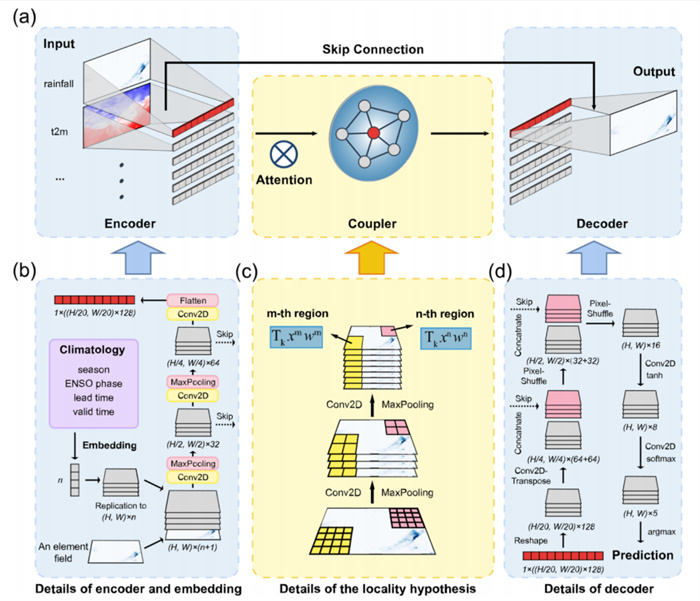In the AI era, pure data-driven meteorological and climate models are gradually catching up with, and even surpassing, traditional numerical models. However, significant challenges persist in current deep learning models, such as low physical consistency and suboptimal forecasting of divergent winds. These limitations hinder the predictive capabilities for complex weather and climate phenomena, including precipitation. A promising approach to address these challenges involves combining physics, atmospheric dynamics, and deep learning models.
A research team led by Prof. HUANG Gang from the Institute of Atmospheric Physics (IAP) at the Chinese Academy of Sciences has made strides in improving precipitation forecasting using a novel approach. Leveraging
EarthLab—a new Earth System Science Numerical Simulator Facility developed by IAP, the team employed data and computational power to enhance numerical models' precipitation forecasting skills. They focused on coupling physical variables through graph neural networks (GNN) to introduce physical constraints and improve the accuracy of precipitation forecasts.
Addressing the difficulties in precipitation forecasting, particularly for heavy rainfall events, the team started by examining the influencing factors and mechanisms behind precipitation. They utilized the omega equation and water vapor equation for variable selection and constructed a variable coupling graph. The omega and water vapor equations describe vertical motion and water vapor changes, both critical factors influencing precipitation. The graph network abstracted these equations into a network structure, representing the nonlinear combinations of fundamental physical quantities and the relationships between key precipitation factors.
Considering the impact of climate factors on weather scales, especially systematic differences in model errors under different climate backgrounds, the study incorporated sparse data, such as seasonality, El Nino Southern Oscillation (ENSO), and initialization time, using entity embedding techniques to calibrate the model. Additionally, the research team localized the ChebNet graph neural network for precipitation, maintaining its effectiveness while significantly reducing computational complexity by avoiding global operations.
The comparison results of the proposed models, omega-GNN and omega-EGNN, against numerical models revealed a significant improvement in precipitation forecasting skills across various categories. The performance of these models surpassed that of mainstream physics-unconstrained deep learning models, such as
U-NET and
3D-CNN. Furthermore, ensemble forecasting, achieved through ten perturbations to all deep learning models, demonstrated the superior consistency and forecasting skills of the physics-constrained omega-GNN and omega-EGNN models, especially for heavy rainfall events.
"We have accumulated substantial expertise in climate dynamics, and in recent years, we have explored ways to enhance weather and climate predictions using AI, garnering awards in related competitions. In the AI era, the integration of physics is a major challenge with various approaches and perspectives. Our team, drawing on atmospheric and climate dynamics considerations, has experimented with applying soft constraints to models from a physical coupling perspective, aiming to contribute incremental information to relevant fields," said Prof. HUANG Gang, the corresponding author of the paper.
The research findings were recently published in the journal
Geophysical Research Letters. This collaborative effort was led by Master's student Chen Yutong, along with Dr. WANG Ya, Prof. HUANG Huang from the Institute of Atmospheric Physics and Dr. TIAN Qun from the Guangzhou Institute of Tropical and Marine Meteorology, China Meteorological Administration.
A general diagram of the omega-GNN model (Image by IAP)

